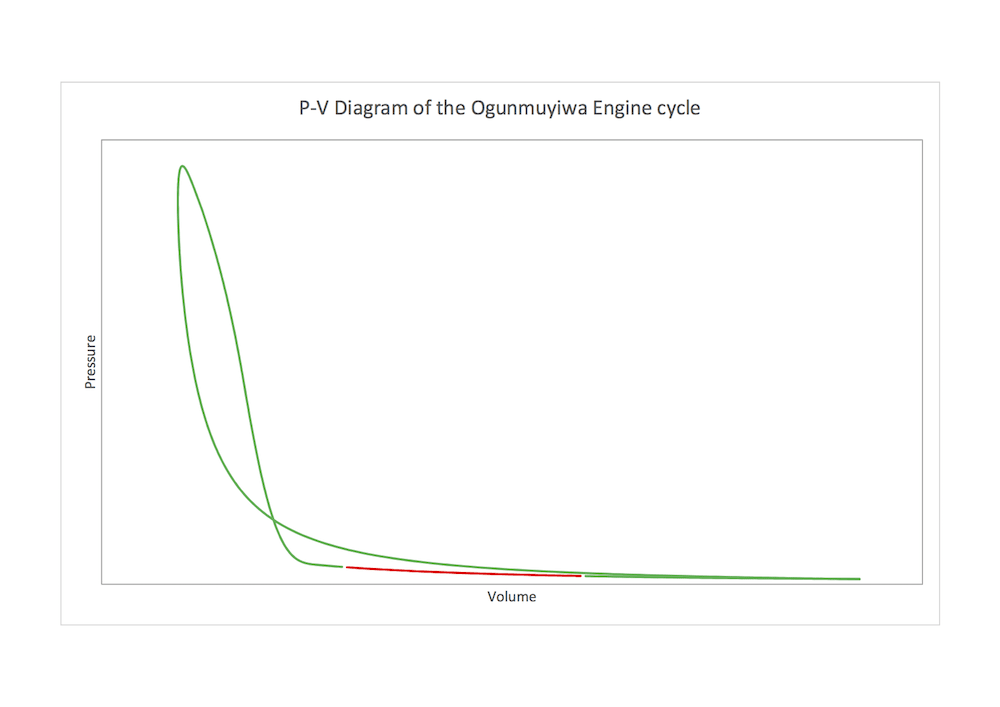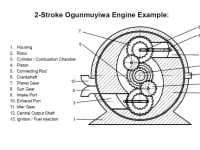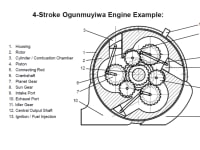The patented "Ogunmuyiwa Engine Cycle" for such engines with their cylinder axes arranged substantially tangentially to a circle centred on main shaft axis, takes advantage of this geometry to carry out the combustion during the compression stroke of the cycle without damaging the engine. This provides a combustion cycle independent of the current inhibitive combustion timing constraints to deliver a more complete combustion, enabling higher power densities, higher thermal efficiencies and lower raw HC & CO emissions to be achieved.
When applied to the “Ogunmuyiwa Planetary Gears Reciprocating Piston Engine” (Ref. WIPO Publication: WO9502114, Claims: 5-7, 9, 11-21) it enables such engines to achieve an indicated thermal efficiency up to 84%. The projected brake thermal efficiency is 60%. This is significantly higher than that what is possible with the current gasoline and diesel engines. The knock resistant geometry of this engine concept enables the higher thermal efficiency to be achieved by converting an increased amount of the energy from the combustion process (the additional torque from the normal force component) into useful work.
In the revolutionary "Ogunmuyiwa Engine Cycle", during the period of combustion of the working fluid on the compression stroke, the burnt gases are successively compressed, causing a temperature increase, which supports the subsequent combustion of the unburnt gases so as to improve the opportunities for achieving a more complete combustion. This will enable vehicle manufacturers to meet the current and upcoming emissions levels with significantly reduced after treatment requirements for HC and CO emissions. Furthermore, carrying out the combustion on the compression stroke opens up opportunities for developing innovative combustion strategies for reducing / avoiding NOx.
The P-V diagram of the Ogunmuyiwa Engine Cycle illustrates the benefits of this cycle over the Otto and Diesel engine cycles. While the work performed on the expansion stroke is still positive, the Ogunmuyiwa Engine Cycle also has significant parts of the compression stroke (at the beginning and the end) where additional positive work is performed. The negative work requirement on the system is therefore limited to the middle part of the compression stroke. This process offers a significant advantage over the Otto and Diesel engine cycles, which have a negative work requirement over the complete compression stroke. This results in the Ogunmuyiwa Engine Cycle achieving a significantly higher thermal efficiency than the Otto and Diesel engine cycles.
For the manufacturability, the engine components have either already been industrialised in reciprocating engines or are similar to Wankel Rotary Engine components which have also been industrialised. Furthermore, these engines will require no valve-train components. Assembly processes similar to those for the Wankel Rotary Engine will be used.
The high efficiency of this engine cycle enhances its marketability by creating the opportunity to layout more compact 2-stroke or 4-stroke engine variants which can replace any existing internal combustion engine in any application, providing improved performance, improved fuel economy and lower emissions. The compact design and the simplicity of the components will give these engines a cost advantage over existing internal combustion engines.
Like this entry?
-
About the Entrant
- Name:Adedapo Ogunmuyiwa
- Type of entry:individual
- Software used for this entry:Borland C
- Patent status:patented








